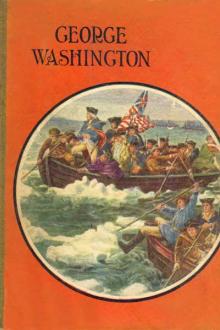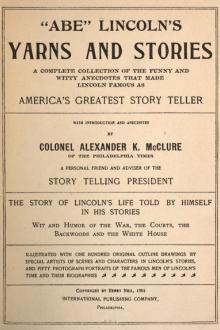The Civil War, James I. Robertson [good ebook reader TXT] 📗

- Author: James I. Robertson
- Performer: -
Book online «The Civil War, James I. Robertson [good ebook reader TXT] 📗». Author James I. Robertson
The principal hand gun for cavalry and infantry officers was the Colt Army Revolver, Model 1860. Over 100,000 of these six-shot, .44-caliber revolvers were manufactured during the war. This same gun, in .36 caliber, was also made for the U. S. Navy. In addition, some twenty other types of pistols were used by soldiers of blue and gray.
In 1836 twenty-two-year-old Samuel Colt patented and produced the first of his famous handguns. The .44 caliber 1860 model, shown above, was known officially as the New Model Army Pistol.
SUGGESTED READINGS Bruce, Robert V., Lincoln and the Tools of War (1956). Fuller, Claud, The Rifled Musket (1958). ____, and Stewart, R. D., Firearms of the Confederacy (1944). Gluckman, Arcadi, United States Muskets, Rifles and Carbines (1948). Lewis, Berkeley R., Small Arms and Ammunition in the United States Service (1956). Mauncy, Albert, Artillery through the Ages (1949). Naisawald, L. Van Loan, Grape and Canister (1960). Peterson, Harold L., Notes on Ordnance of the American Civil War, 1861-1865 (1959). Wainwright, Charles S., A Diary of Battle, ed. Allan Nevins (1962). Wise, Jennings C., The Long Arm of Lee (1915, 1959).This damaged wetplate, made in June, 1863, shows the 17th New York Battery drawn up in line near Washington, D. C.
IX. LEADERSAbraham Lincoln (1809-1865) and Jefferson Davis (1808-1889) were born in Kentucky only a few miles apart. Lincoln educated himself, eventually settled in Illinois, and became a highly successful frontier attorney.
Davis graduated from West Point, became a wealthy Mississippi planter, and served successively as Secretary of War and U. S. senator. Both men were tall and of striking appearance; both married strong-willed women.
The destiny of Civil War America lay largely in the hands of four men: Abraham Lincoln, Jefferson Davis, Ulysses Simpson Grant, and Robert Edward Lee. Since an abundance of printed works exists on the lives and careers of these leaders, given here are but a few generalities concerning each.
In many respects, Lincoln long seemed mysteriously complex. But those who knew the man quickly dropped any impression that Lincoln was crude or provincial. “He is the best of us all,” his Secretary of State, William H. Seward, once stated. The solemn-looking Lincoln was a deeply earnest chief executive who devoted his last four years to reuniting a shattered nation that he loved dearly and to raising the nation to a higher moral and spiritual level. He was kind, genial, compassionate, and religious (though he attended church without joining any denomination).
Lincoln possessed several ingredients of greatness. He had a deep love of humanity, a keen understanding of men, and a fantastic patience with the generals and politicians who tried him by their lack of strength and capacity. He was also a man of total integrity and deep humility. As a patriot he believed firmly that “this government of the people, by the people, and for the people, shall not perish from the earth.” Not once in those years of passion did he express the slightest hatred for the Union’s enemies. In his second inaugural address, delivered a month before his death in 1865, Lincoln closed by stating: “With malice toward none, with charity for all, with firmness in the right as God gives us to see the right, let us continue the work we are in ... [and] do all that may achieve a just, and a lasting peace, among ourselves, and with all nations.”
On July 7, 1865, four persons convicted of conspiracy in the assassination of Lincoln were hanged at the Washington Arsenal. Among the four was Mrs. Mary Surratt (second from left), the first woman in America to be executed for a capital offense.
Jefferson Davis, President of the Confederacy, deserves better treatment than history has accorded him. The years have not been kind to his memory for two reasons: 1) he led the losing side; 2) when compared to his Northern counterpart, Lincoln, Davis left much to be desired in both personality and statesmanship. Unlike Lincoln, Davis was handsome, well-educated, and experienced in political and military affairs. However, he lacked administrative skill. He tried to do all of the government’s work—and he was a slow worker. Worst of all, Davis was never able to gain the affection of his people in a degree remotely approaching the love heaped on Lincoln by the North.
Yet Davis did his best in an impossible job. He was harassed and criticized by jealous governors, independent generals, an apathetic vice-president, and a Confederate Congress more noted for constant arguing than for constructive activity. Ever-present from without was an enemy that heavily outweighed the South in resources.
The Confederate “White House” in Richmond stands at the end of East Clay Street. President Davis and his family lived in this imposing three-storied home throughout the four years of war. The home is now a noted museum.
Davis was in a sense doomed to failure from the start, but his devotion to the South never wavered. In spite of many physical handicaps, he demonstrated throughout his life honesty, courage, fortitude, and a firmness in the right as he saw the right. In sectional terms, he may be adjudged one of the true patriots in American history.
Military analysts often assert that U. S. Grant was “the first of the modern generals” and that Robert E. Lee was “the last of the old-fashioned generals.” What this implies is that two able field commanders fought one another differently: Grant introducing all-out, total war, Lee relying on a 500-year-old concept of limited warfare.
Certainly Grant was original in much of his strategy. To him a single victory meant very little. The long-range result of a continual hammering was the important factor. “The art of war is simple enough,” he once stated. “Find out where your enemy is. Get at him as soon as you can. Strike at him hard as you can, and keep moving on.” Grant’s aggression, therefore, became attrition—that is, a skillful, systematic grinding down of the South’s whole capacity to fight. War under Grant became modern war: all-inclusive and brutal. He meant it that way, for he always thought of war as a cruel, bloody business to be ended as quickly as possible.
Ulysses S. Grant (1822-1885) was born in Ohio, entered the Civil War from Illinois, and spent his last years in New York. He served two terms as 18th President of the U. S. Grant completed his memoirs only a week before his death from throat cancer.
Robert E. Lee (1807-1870) was the son of Virginia’s Revolutionary War hero, “Lighthorse Harry” Lee. Following a distinguished army career, Lee became president of impoverished Washington College (now Washington and Lee University).
This short, unimpressive looking general succeeded where others had failed because he had the willingness to give an order and the strength to see it carried out. He did not use the lightning tactics of Napoleon or Lee. Yet he had the determination and stubbornness to keep plodding after the enemy. He was thus a soldier of the mold of Frederick the Great and the Duke of Wellington. Perhaps Lincoln best summed up Grant when he answered criticisms of the general with the observation: “I can’t spare this man. He fights.”
Robert E. Lee has two historical handicaps: 1) he fought against the Union; and 2) he is the only American general who ever lost a war. Yet practically everyone who studies the life of this devoted Virginian soon agrees with Sir Winston Churchill, who termed Lee “one of the noblest Americans who ever lived, and one of the greatest captains known to the annals of war.”
Lee is most remembered for an almost flawless character. He did not believe in slavery, but his heart and birthright were in Virginia. Therefore, he turned down command of all U. S. forces in 1861 and offered his services to his native state. As an army commander Lee usually displayed great boldness in action, an ingenious capacity for choosing the right field positions, and an uncanny ability to anticipate his opponent’s next move. With faith in his own judgment and in the fighting quality of his army, Lee would then devise his strategy. Confederate politics forced Lee to fight for the most part on the defensive, and many writers attribute the Southern nation’s long life to Lee’s genius in combating an enemy that sometimes greatly outnumbered him.
Lee’s chief weaknesses as a general were his depthless humility and courtesy. Too often he entrusted to his principal lieutenants decisions he himself should have made. He seemed always to assume that everyone around him would strive for victory as earnestly and as completely as he did. Much of this devotion to principle did rub off on his army. One of Lee’s sharpest critics eventually admitted: “Few generals have been able to animate an army as [Lee’s] self-sacrificing idealism animated the Army of Northern Virginia.... What this bootless, ragged, half-starved army accomplished is one of the miracles of history.”
SUGGESTED READINGS Catton, Bruce, Grant Moves South (1960). Chambers, Lenoir, Stonewall Jackson (2 vols., 1960). Cleaves, Freeman, Meade of Gettysburg (1960). ____, Rock of Chickamauga: The Life of General George H. Thomas (1948). Dodd, William E., Jefferson Davis (1907). Dyer, John P., The Gallant Hood (1950). Freeman, Douglas S., R. E. Lee: A Biography (4 vols., 1934-35; 1 vol. ed., 1961). Fuller, John F. C., The Generalship of Ulysses S. Grant (1929, 1958). Govan, Gilbert E., and Livingood, J. W., A Different Valor: The Story of General Joseph E. Johnston, C.S.A. (1956). Hassler, Warren W., Jr., George B. McClellan: Shield of the Union (1957). Henry, Robert S., “First with the Most” Forrest (1944). Horn, Stanley F., ed., The Robert E. Lee Reader (1949). Hyman, Harold M., and Thomas, B. P., Stanton: The Life and Times of Lincoln’s Secretary of War (1962). Lamers, William M., The Edge of Glory: A Biography of General William S. Rosecrans (1961). Lewis, Lloyd, Captain Sam Grant (1950). ____, Sherman, Fighting Prophet (1932). McElroy, Robert, Jefferson Davis: The Unreal and the Real (2 vols., 1937). Maurice, Frederick, Robert E. Lee, the Soldier (1925). Nicolay, John G., and Hay, John, Abraham Lincoln: A History (10 vols., 1914). Sandburg, Carl, Abraham Lincoln: The Prairie Years (2 vols., 1926). ____, Abraham Lincoln: The War Years (4 vols., 1939). Sanger, Donald B., and Hay, T. R., James Longstreet (1952). Strode, Hudson, Life of Jefferson Davis (2 vols., 1958-59). Thomas, Benjamin P., Abraham Lincoln (1952). Thomason, John W., Jr., Jeb Stuart (1930). Vandiver, Frank E., Mighty Stonewall (1957). Wiley, Bell I., The Road to Appomattox (1956). Williams, T. Harry, Lincoln and His General (1952). ____, P. G. T. Beauregard: Napoleon in Gray (1955). X. THE COMMON SOLDIERSThe average Civil War soldier was a farm boy between 18 and 30 years of age. He possessed little formal education; and by modern-day standards, his military training was superficial. He was more fighter than soldier, and he tended to scoff at military discipline and other formalities of army service.
Posing for photographs to send home to loved ones was a favorite pastime of Civil War soldiers. Typical servicemen of that period were, from left to right: Pvt. George A. Stryker of New York, Pvt. John W. Branch of the 12th Tennessee (C.S.A.), and Pvt. Philip Carper of the 35th Virginia Cavalry.
Several factors prompted his voluntary entrance into the army. Intense patriotism, the determination to fight for one’s particular cause, the enticement of enlistment bounties, or the simple love of adventure were all strong inducements. Many men, however, were drafted into service when both sides resorted to conscription in 1862.
In that same year the





Comments (0)